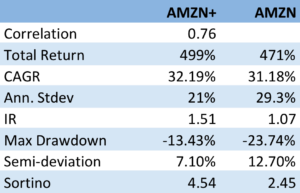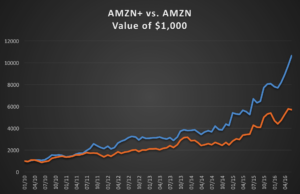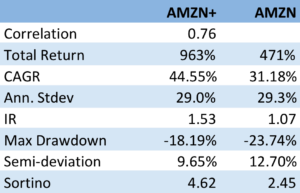Amazon (NASDAQ:AMZN) has been on a tear over the last decade, especially since the financial crisis of 2008. If you had been smart (or lucky) enough to buy the stock at the beginning of 2010, each $1,000 you invested would now be worth over $5,700, giving a CAGR of over 31%.
Source: Yahoo! Finance
It’s hard to argue with success, but could you have done better? The answer, surprisingly, is yes – and by a wide margin.
Introducing AMZN+
I am going to reveal this mystery stock in due course and, I promise you, the investment recommendation is fully actionable. For now, let’s just refer to it as AMZN+.
A comparison between investments made in AMZN and AMZN+ over the period from January 2010 to June 2016 is shown the chart following.
Visually, there doesn’t appear to be much of a difference in overall performance. However, it is apparent that AMZN+ is a great deal less volatile than its counterpart.
The table below give a more telling account of the relative outperformance by AMZN+.
The two investments are very highly correlated, with AMZN+ producing an extra 1% per annum in CAGR over the 6 ½ year period.
The telling distinction, however, lies on the risk side of the equation. Here AMZN+ outperforms AMZN by a wide margin, with an annual standard deviation of only 21% compared to 29%. What this means is that AMZN+ produces almost a 50% higher return than AMZN per unit of risk (information ratio 1.51 vs. 1.07).
The more conservative risk profile of AMZN+ is also reflected in lower maximum drawdown (-13.43% vs -23.74%), semi-deviation and higher Sortino Ratio (see this article for an explanation of these terms).
Bottom line: you can produce around the same rate of return with substantially less risk by investing in AMZN+, rather than AMZN.
Comparing Equally Risky Investments
There is another way to make the comparison, which some investors might find more appealing. Risk is, after all, an altogether more esoteric subject than return, which every investor understands.
So let’s say the investor adopts the same risk budget as for his original investment in AMZN, i.e. an annual volatility of just over 29%. We can produce the same overall level of risk in AMZN+, equalizing the riskiness of the two investments, simply by leveraging the investment in AMZN+ by a factor of 1.36, using margin money. i.e. we borrow $360 and invest a total of $1,360 in AMZN+, for each $1,000 we would have invested in AMZN. Look at the difference in performance:
The investor’s total return in AMZN+ would have been 963%, almost double the return in AMZN over the same period and with a CAGR of over 44.5%, more than 13% per annum higher than AMZN.
Note that, despite having an almost identical annual standard deviation, AMZN+ still enjoys a lower maximum drawdown and downside risk than AMZN.
The Big Reveal
Ok, so what is this mystery stock, AMZN+? Actually it isn’t a stock: it’s a simple portfolio, rebalanced monthly, with 66% of the investment being made in AMZN and 34% in the Direxion Daily 20+ Yr Trsy Bull 3X ETF (NYSEArca: TMF).
Well, that’s a little bit of a cheat, although not much of one: it isn’t too much of a challenge to put $667 of every $1,000 in AMZN and the remaining $333 in TMF, rebalancing the portfolio at the end of every month.
The next question an investor might want to ask is: what other stocks could I apply this approach to? The answer is: a great many of them. And where you end up, ultimately, is with the discovery that you can eliminate a great deal of unnecessary risk with a portfolio of around 20-30 well-chosen assets.
The Fundamental Lesson from Portfolio Theory
We saw that AMZN incurred a risk of 29% in annual standard deviation, compared to only 21% for the AMZN+ portfolio. What does the investor gain by taking that extra 8% in annual risk? Nothing at all – in fact he would have achieved a slightly worse return.
The key take-away from this simple example is the fundamental law of modern portfolio theory:
The market will not compensate an investor for taking diversifiable risk
As they say, diversification is the only free lunch on Wall Street. So make the most of it.






